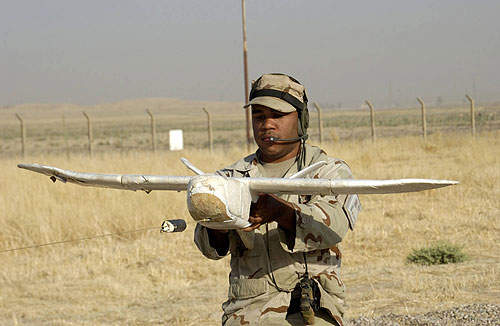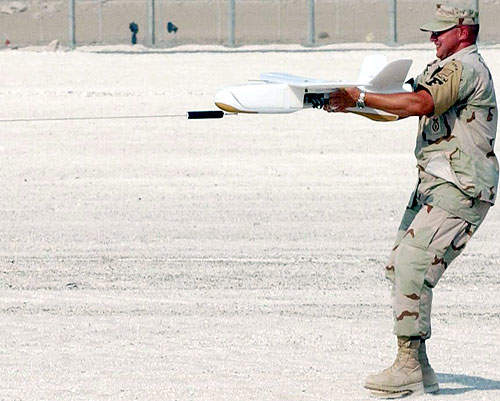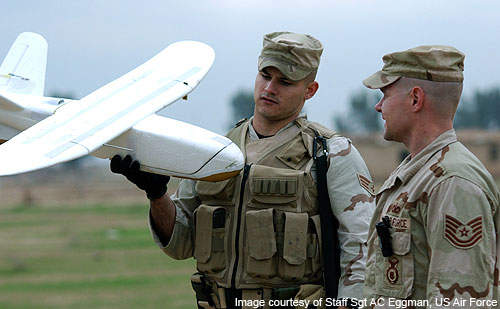The Desert Hawk III (DHIII) is an advanced miniature unmanned aerial vehicle (UAV) system designed and manufactured by Lockheed Martin’s Skunk Works team in the US.
The UAV was built for UK military forces and the US Air Force (USAF) to provide force protection for patrols and convoys, base security, route clearance, target tracking and reconnaissance. The aircraft is deployed on counterterrorism operations by UK military forces.
The UAV performs a wide range of missions including quick mission planning, enhanced day or night surveillance, target detection, recognition, identification, greater operational range, endurance, intelligence and reconnaissance operations. The aircraft made its maiden flight in 2003.
DHIII was deployed by the USAF in Afghanistan to increase the protection of airbase perimeters. The aircraft can identify military troops carrying shoulder-fired missiles from 10km radius.
Flying at an altitude of 150m, the DHIII can provide its operators with real-time and video imagery of the battlefield by performing night surveillance and aerial video reconnaissance over a large area.
Desert Hawk III UAV orders and deliveries
The first shipments of the Desert Hawk III UAVs were delivered to the British Army 32 Regiment, and the Royal Artillery in Iraq in 2007 as a replacement of the aging Phoenix system.
Lockheed Martin was awarded a $4.8m contract by the UK Ministry of Defence in November 2007 to supply additional DHIII unmanned aerial system (UAS).
DHIII minature UAV design
The DHIII has been designed to be a lightweight, hand-launched rough air vehicle. Its unique design maximises the target detection and recognition capability while allowing the aircraft to operate in high wind environments. The UAV’s improvised wing design reduces the minimum take-off and landing speed and offers easier launch and recoveries in difficult terrain environments. The aircraft can be landed without the requirement of the runway.
DHIII development
The Desert Hawk III system comprises a tough air vehicle, three plug-and-play payloads, and a portable ground control station. The stabilised two-axis turret mounted on the top of a laptop touchscreen delivers videos transmitted from long distance to the ground control station. The UAV provides operator training, automatic preflight planning, in-flight control of plug-and-play optical and infrared sensors, terrain rejection measures and flight profile retasking. DHIII is made up of highly flexible and damage resistant mould-injected and expanded polypropylene.
The flight testing of DHIII following installation of the new signal intelligence (SIGINT) was successfully completed by Lockheed Martin in May 2009. The SIGINT system detects and tracks videos of RF emissions. DHIII was deployed in Afghanistan and Iraq in 2009.
DHIII landing is difficult as it is not fitted with wheels. The operator has to control the crush to perform a safe landing. Crush can be controlled by ensuring that the wind, angle of descent and terrain are correct. Kevlar skids installed on the aircraft’s nose and tail section aid in safe landing and enhance the durability of the UAV.
Sensors
The UAV is incorporated with electro-optical (EO) and infrared (IR) sensors, laser illuminator, gyro-stabilised 360° sensor, long-wave infrared imager (LWIR) and roll-stabilised infrared sensor in the middle portion of the fuselage section.
The EO sensor converts light rays into electronic signals for capturing images, real-time data and videos. The laser illuminator is invisible to operators and captures videos in total darkness using night vision equipment.
Radars
The DHIII is fitted with SAR (synthetic aperture radar), SIGINT (signal intelligence) and COMINT (communication intelligence).
Engines
The UAV is powered by a single electric motor driving a pusher quiet propeller. This propulsion system allows the Desert Hawk III to take off or land vertically.
DHIII ground control station
The DHIII features two ground control station (GCS) configurations and a remote viewing terminal. The GCS is designed and manufactured by Lockheed Martin. The first configuration incorporates independent communication systems and antennas, and the second configuration includes integrated systems that reduce the setup time while offering great portability and mobility for warfighters.
The digital and infrared cameras fitted in the UAV capture real-time videos of enemies and transmit them to the GCS through a GPS receiver.
The GCS has a touchscreen laptop used for viewing the video imagery transmitted by the UAV. The communication links and the global positioning system (GPS) antenna are mounted on the aircraft’s wings for transmitting or receiving commands from ground control station.
The aircraft flies automatically when the operator specifies the route on the laptop screen. The operator can continuously track the imagery transmitted from the on-board cameras.
Desert Hawk III performance
The UAV can cruise at a maximum speed of 92km/h. The maximum altitude and range of the Desert Hawk III are 150m and 15km respectively. Its endurance is one hour 30 minutes. The aircraft weighs around 3kg and its maximum take-off weight is 1kg.







